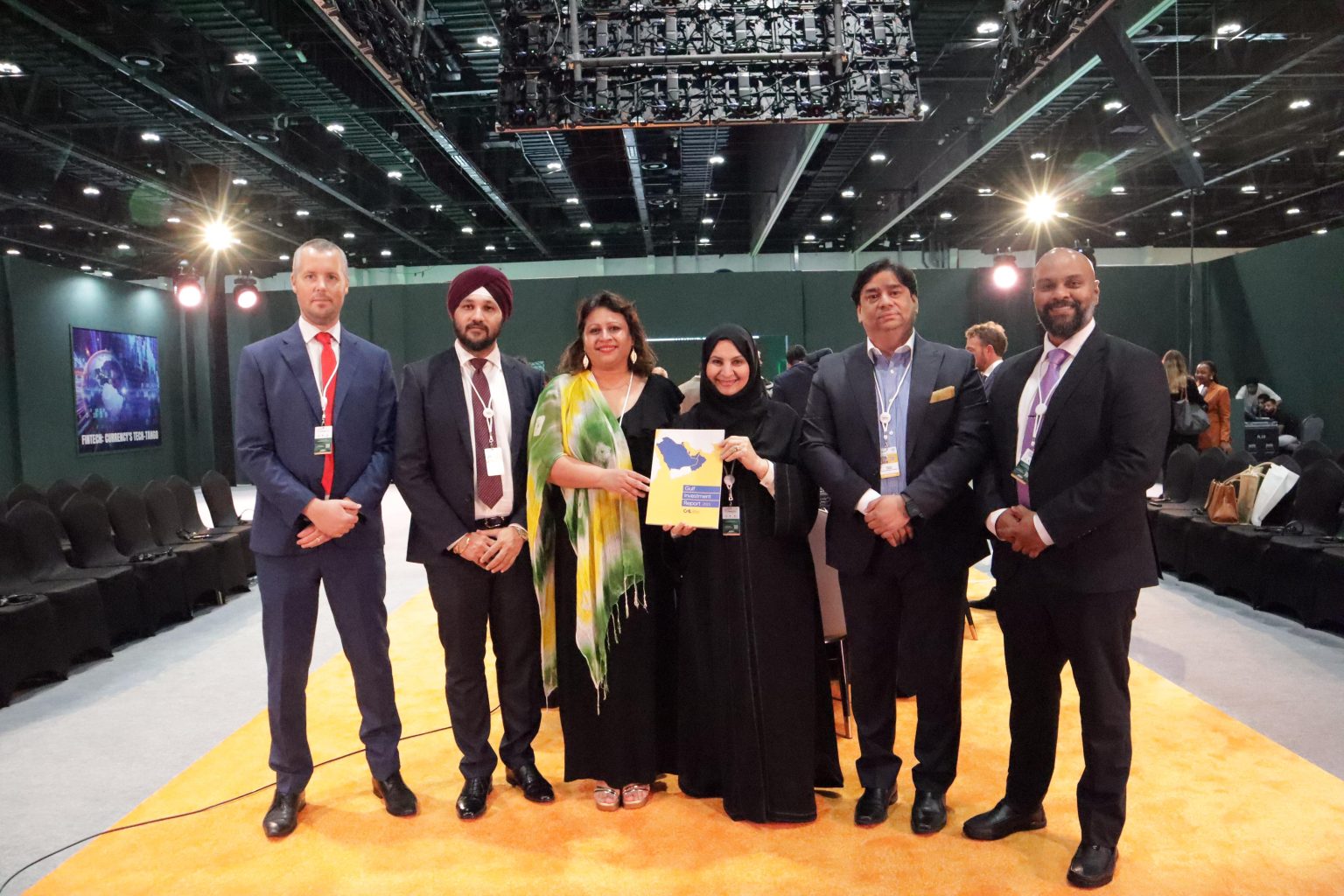Published by Century International Holdings Ltd, Gulf Investment Report 2023 is a comprehensive research put together to help investors to chart their strategy for future growth
The Gross Domestic Product (GDP) of the Gulf countries could more than double to US$13 trillion, up from a projected US$6 trillion by 2050, if the countries embrace a green growth strategy;
The UAE has invested more than US$40 billion in clean energy over the last 15 years, and has plans to invest an additional US$163.5 billion (Dh600 billion) in clean and renewable energy sources over the next three decades on the road to net zero;
Total FDI flow into the GCC region declined 17.91 percent to US$37.12 billion in 2022, down from US$45.22 billion recorded in 2021, despite the UAE recording a 10 percent increase in FDI from US$20.66 billion in 2021 to US$22.73 billion in 2022, according to the World Investment Report 2023;
GCC region’s inward FDI stock rose to US$529.78 billion at the end of 2022. This is at the backdrop of a 12 percent decline in global FDI flow to US$1.3 trillion in 2022;
The combined Gross Domestic Product (GDP) of the hydrocarbon-rich Gulf countries could more than double from a projected US$6 trillion to US$13 trillion by 2050, if the countries embrace a green growth strategy, according to a research report, Gulf Investment Report 2023, published by Century International Holdings Ltd, that is released at the World Investment Forum 2023 currently underway in Abu Dhabi.
The combined GDP of the GCC countries has already touched the US$2 trillion mark. Investment in green and sustainable projects could transform the region a global economic powerhouse.
“Gulf Investment Report 2023 has been initiated by Century Group as a knowledge series developed through in-depth data compilation for the wider industry stakeholders that will help them chart their future growth strategy and re-adjust their expansion plan as per the ground reality,” Bal Krishen Rathore, Chairman of Century International Holdings Ltd (CIHL), said.
However, the economic potential of the Gulf countries is not reflected in the global Foreign Direct Investment (FDI) ranking published every year in the annual World Investment Reports released by the United Nations Conference on Trade and Development (UNCTAD).
Total FDI flow into the GCC region declined 17.91 percent to US$37.12 billion in 2022, down from US$45.22 billion recorded in 2021, despite the UAE recording a 10 percent increase in FDI from US$20.66 billion in 2021 to US$22.73 billion in 2022, according to the World Investment Report 2023.
This is lower than the US$46.96 billion FDI attracted by Sweden last year and way below than the US$117.73 billion FDI received by Hong Kong or the US$141.21 billion FDI attracted by Singapore.
Despite this decline, the total FDI inflow into the GCC countries more than doubled in six years, reaching US$37.12 billion in 2022, up from US$15.52 billion in 2017 – which demonstrates a strong growth in the overall investment landscape.
GCC region’s inward FDI stock rose to US$529.78 billion at the end of 2022. This is at the backdrop of a 12 percent decline in global FDI flow to US$1.3 trillion in 2022, according to the Gulf Investment Report 2023.
However, in the GCC, the UAE stands out in terms of attracting investment. FDI inflow of US$22.73 billion into the UAE in 2022 represents 61.24 percent of the total FDI inflow of US$37.12 billion into the GCC in 2022, the records show. The UAE ranks fourth globally in greenfield investment projects with the number of projects reaching 997 in 2023, according to the World Investment Report 2023.
“The GDP of the GCC region has already touched the US$2 trillion mark. If the GCC countries continued business as usual, their combined GDP would grow to an expected US$6 trillion by 2050. However, embracing a green growth strategy could see the GCC GDP grow to over US$13 trillion by 2050,” World Bank said in an economic update.
Issam Abou Sleiman, Regional Director of World Bank in the MENA region, said, “The GCC economies have been a bright spot in an otherwise dark economic landscape. Average growth in the GCC surpassed 7 percent in 2022 led by Saudi Arabia, its biggest economy, which was globally the fastest growing large economy.
“The transition to a low-carbon economy has been accelerated by high oil and gas prices and the need for greater energy security in the wake of the war in Ukraine. Renewable energy industries will witness trillions of dollars of new investment as well as opportunities in upstream and downstream industries.
“The region also has the potential to be a lead producer of green and blue hydrogen. With the right regulations, policies, and investments to support the transition, GCC countries can emerge with stronger, more sustainable economies that generate rewarding jobs for their youth while simultaneously protecting the planet.”
The GCC countries have been attracting investment from all over the world for quite some time now. Information on investment have been published in bits and pieces in a scattered manner without coordination.
Habiba Al Marashi Al Hashimi, Co-Founder & Chairperson of the Emirates Environmental Group
And Board Member of Global Investors for Sustainable Development Alliance, said, “There has been a gap in putting together a comprehensive economic research book on investment across all economic sectors. As the region gains significance in the global community and aligns itself with the global growth and development, it becomes imperative for us to study, analyse and generate conclusion based on real data so that we, the industry stakeholders can map the future direction and trends.
“For example, environment and sustainability has gained momentum now, while some of us have been campaigning for it for the last three decades. I am glad to know that CIHL has undertaken this significant step through Gulf Investment Report 2023 to fill up this important knowledge gap.
“It is heartening to know that Gulf Investment Report 2023 also highlights investment in clean, green energy and environmental sustainability – areas in which the UAE has taken a leadership role in the region and the world – through the launch of Masdar – the world’s first carbon-neutral urban development, the development of the region’s first nuclear power plant, as well as the development of the world’s largest solar park – Mohammed Bin Rashid Solar Park, just to name a few.
“The UAE is investing heavily in clean and renewable energy. Despite being an oil producing country, the UAE has invested more than US$40 billion in clean energy over the last 15 years, and has plans to invest an additional US$163.5 billion (Dh600 billion) in clean and renewable energy sources over the next three decades on the road to net zero.”
The astonishing economic growth of the GCC countries, particularly the United Arab Emirates (UAE), over the past five decades is nothing short of a remarkable economic miracle. However, this remarkable growth story has often lacked comprehensive, updated statistics and credible information that researchers can use to dissect and analyse the region’s economic evolution. The Gulf Investment Report 2023, spearheaded by Century Financial Group, endeavours to address this critical gap in economic research.
GCC countries can realise up to US$300 billion in foreign direct investment if they move quickly to seize the opportunity of becoming a centre for Global Value Chains (GVC) that are being reconfigured towards resilient and sustainable industries, according to a report by Strategy&.
The member countries of the GCC region have been relaxing their investment regime to allow greater foreign investment. Some of the member states including the UAE, Bahrain and Qatar now allow 100 percent foreign ownership in businesses and they have eliminated the mandatory requirement of a local partner in the mainstream on-shore businesses in most categories of businesses.
In 2019, the UAE Government launched the 10-year Golden Visa scheme – that has helped attracted a large pool of investors to not only invest in the UAE economy, but also to relocate their businesses in the UAE. In selected cases, the UAE Government also had started giving UAE passports to investors who fulfil certain criteria.
Foreign Direct Investment
Table
FDI Inflows into GCC Countries
(Amount in US$ million)
| Country | 2017 | 2018 | 2019 | 2020 | 2021 | 2022 |
| Bahrain | 1,426 | 1,654 | 1,548 | 1,021 | 1,779 | 1,951 |
| Kuwait | 348 | 204 | 351 | 240 | 567 | 758 |
| Oman | 2,988 | 6,455 | 4,237 | 2,889 | 4,021 | 3,716c |
| Qatar | 986 | -2,186 | -2,813 | -2,434 | -1,093 | 76 |
| Saudi Arabia | 1,419 | 4,247 | 4,563 | 5,399 | 19,286 | 7,886 |
| UAE | 10,354 | 10,385 | 17,875 | 19,884 | 20,667 | 22,737 |
| Total GCC | 17,521 | 20,759 | 25,761 | 26,999 | 45,227 | 37,124 |
Source: World Investment Report, UNCTAD
FDI Inward Stock
(Amount in US$ million)
| Country | 2000 | 2010 | 2021 | 2022 |
| Bahrain | 5,906 | 15,154 | 33,484 | 35,436 |
| Kuwait | 608 | 11,884 | 15,531 | 15,091 |
| Oman | 2,577c | 14,987 | 45,844 | 49,560c |
| Qatar | 1,912 | 30,549 | 27,534 | 27,610c |
| Saudi Arabia | 17,577 | 176,378 | 261,061 | 268,947 |
| UAE | 1,069c | 63,869 | 171,563 | 194,300 |
| Total GCC | 29,649 | 312,821 | 555,017 | 590,944 |
Source: World Investment Report, UNCTAD




